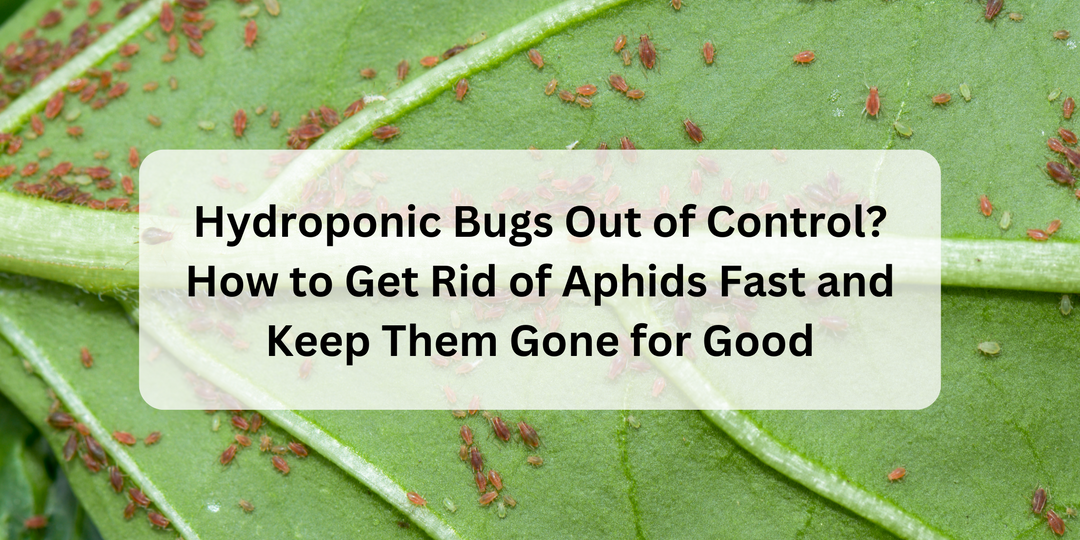How to Grow Tomatoes Hydroponically Indoors: Little Effort, Big Garden Method
Ever wondered how to grow tomatoes hydroponically right in your kitchen? Trust me, there’s nothing like the satisfaction of plucking a ripe, juicy tomato from your own indoor garden—especially when it’s grown using hydroponics. You might not have a sprawling backyard, but with the little effort, big harvest method, you don’t need one. Growing tomatoes hydroponically indoors isn’t just for gardening pros; it’s for anyone who loves the idea of fresh, homegrown tomatoes at their fingertips. And let’s be honest, homegrown tomatoes just taste better—juicier, sweeter, and packed with that “I did this!” flavor you can’t find at the store. Plus, it’s a great way to turn a small space into a thriving tomato jungle, without the bugs and back-breaking work.
In this blog, we’re going to show you step by step how to easily grow tomatoes hydroponically indoors. From how to grow, trouble shooting and much more. It all starts with a solid foundation, and that means choosing the proper variety.

Choosing the Right Tomato Variety: Determinate vs. Indeterminate
Selecting the right tomato variety is crucial for a successful indoor hydroponic garden. For indoor systems, determinate and dwarf varieties are typically the best options. Let’s explore why these varieties are ideal and what makes them different from their indeterminate counterparts.
What Are Determinate Varieties?
Determinate tomato plants are a fantastic choice for indoor gardens. They grow to a specific height, forming a compact, bush-like shape that’s easy to manage. Once they reach their mature size, they focus on producing a large batch of tomatoes that ripen all at once. After this initial harvest, they don’t stop; they just slow down, continuing to provide smaller waves of tomatoes over time. These plants are designed to stay small, which means you can maximize your yield without the constant hassle of pruning and training unruly vines. And when it comes to flavor, you’re not sacrificing a thing—determinate varieties offer just as much deliciousness as their larger, more sprawling relatives. With these plants, you’ll enjoy a bountiful, flavorful harvest without worrying about your indoor garden turning into a jungle.
Examples of excellent determinate varieties for indoor growing include:
- Red Robin: A small, bushy plant that stays compact, perfect for tight spaces, and produces sweet, tangy tomatoes ideal for snacking or salads.
- Tiny Tim: This dwarf variety grows to about 12-18 inches tall, making it perfect for small indoor setups, and yields bite-sized tomatoes with a classic, sweet flavor.
- Patio: A space-saving determinate plant that reaches around 2 feet in height, offering medium-sized tomatoes with a rich, full flavor, perfect for slicing and sandwiches.
What Are Indeterminate Varieties?
Indeterminate tomato plants, on the other hand, grow continuously throughout the season. These plants keep getting taller and bushier, producing flowers and fruit along the way. While this might sound appealing, there’s a catch: because you’re growing indoors where there’s no natural season to stop them, indeterminate varieties can almost turn into weeds—they just keep growing and growing. If you don’t carefully manage them, they can take over your indoor space. They require a lot more work, including regular pruning, trellising, and training to keep them from sprawling all over your system. Essentially, they’re high-maintenance guests that need constant attention.
How to Identify Determinate and Indeterminate Varieties
Wondering how to tell the difference between determinate and indeterminate varieties? It’s usually indicated right on the seed packet or plant tag. Here’s what to look for:
-
Determinate Varieties: Look for keywords like “bushy,” “compact,” or “ideal for containers.” These terms suggest a plant that will grow to a certain height, then focus on fruit production without becoming too unruly.
-
Indeterminate Varieties: These are often labeled as “vining,” “continuous growers,” or “indeterminate.” These plants need more space and support, as they’ll keep growing and producing throughout the season, requiring more maintenance to manage their growth.
Once you’ve chosen your tomato variety, it’s time to set up your indoor hydroponic system to create the perfect environment for your plants to thrive. From lighting and temperature to the right nutrients, every detail matters when it comes to helping your tomatoes reach their full potential. Let’s break down exactly what your tomatoes need at each stage of their growth journey.
Creating the Ideal Growth Environment for Hydroponic Tomatoes

Light: The Energy Source
Tomatoes are true sun-lovers, so providing ample light is essential for healthy growth indoors. Aim to give your plants 14-18 hours of light per day. Your grow lights should be powerful enough to support vigorous growth, especially once the plants start flowering and fruiting. For a rough estimate, you’ll want at least 40 watts per square foot to ensure your tomatoes are getting the energy they need to thrive.
Temperature: Warmth for Growth
Tomatoes thrive in warm conditions. Keep the daytime temperature between 70-85°F (21-29°C) and allow it to drop slightly at night. This temperature range mimics their natural environment and helps your plants grow strong and healthy, leading to a more productive harvest. Avoid letting the temperature drop too low at night, as tomatoes are sensitive to cold and could experience slowed growth and reduced fruiting.
Spacing: Room to Grow
Proper spacing is crucial, especially for tomatoes, as they need room to spread their roots and grow their foliage. Even if you’re growing determinate varieties, which stay compact, you should space your plants about 12-24 inches apart depending on the variety. This spacing ensures good air circulation, which helps prevent diseases like powdery mildew and keeps your plants stress-free. If you’re growing indeterminate varieties, this spacing becomes even more important as they continue to grow throughout the season.
Nutrient Management: Feeding Your Hydroponic Tomatoes Right
Nutrient management is the cornerstone of successful hydroponic gardening, especially when it comes to tomatoes, which are known to be heavy feeders. These plants require a well-balanced and carefully monitored nutrient supply to reach their full potential. From the early stages of growth to the blooming stage, every phase requires attention.
Ensuring your tomatoes receive the right nutrients at the right time is crucial for promoting vigorous growth, maximizing fruit yield, and maintaining overall plant health in your hydroponic system.
- Vegetative Stage: When your tomato plants are young and focused on building strong stems and leaves, they require a nutrient solution high in nitrogen. This nutrient ratio helps lay a solid foundation for your plants, ensuring they develop the structure needed to support future fruit.
- Blooming Stage: As soon as you see the first flowers, it’s time to switch to a blooming nutrient ratio. This blend is higher in phosphorus and potassium, which are critical for flower and fruit development.
There are two ways to switch nutrients:
- Gradual Switch: When your system needs a refill, dilute the current nutrient solution with water, then flush the system after a few days before adding the blooming nutrients. This gradual transition helps your plants adjust smoothly to the change in nutrients.
- Optimized Switch: For a quicker transition, empty your reservoir as soon as you see flowers and refill it with the blooming nutrient solution. This method ensures your plants get the nutrients they need immediately, helping them focus on fruit production.
pH Levels: The Balance Point
Maintaining the pH level between 5.5-6.5 is crucial for nutrient uptake. If the pH is too high or too low, your plants may struggle to absorb the nutrients they need, even if your solution is perfectly balanced. Regularly check and adjust the pH to keep it within this optimal range, ensuring your tomatoes have everything they need for robust growth and abundant fruit production.
Pollination: Ensuring a Bountiful Hydroponic Tomato Harvest

Once your tomato plant is growing and starts producing flowers, you’ll need to make sure those flowers get pollinated to set fruit.
Tomatoes have what’s called perfect flowers, meaning each flower contains both male and female reproductive organs. This setup allows them to self-pollinate, but when you’re growing tomatoes indoors, the natural movement of air and insects that typically assist with pollination is missing. That’s where you come in.
To help your tomatoes along, you can gently shake the plants, mimicking the natural movement that would normally distribute the pollen. This simple action can often be enough to ensure pollination. However, if you want to be more hands-on, you can use a small brush or cotton swab to manually transfer pollen from the stamens (the male part of the flower) to the pistils (the female part). This method gives you more control and can be especially helpful if you’re noticing that some flowers aren’t setting fruit.
Another effective technique is to place a small fan near your plants. The fan can create a gentle breeze, helping to move the pollen around just like the wind would outdoors. This approach is particularly useful if you’re growing multiple plants close together and want to ensure thorough pollination across all of them.
Troubleshooting Common Issues with Hydroponic Tomatoes
Even with the best care, things don’t always go as planned. Here’s how to troubleshoot some common problems you might encounter when growing hydroponic tomatoes.
Lots of Flowers but No Fruits: Is Pollination the Issue?
If your tomato plants are producing plenty of flowers but no fruit, the most likely culprit is poor pollination. Since you’re growing indoors, there’s no natural wind or insects to help with this process, making manual pollination essential. Try gently shaking the plants to help move the pollen, or use a small brush or cotton swab to transfer pollen from one part of the flower to another. If you’re already doing this, try increasing the frequency to ensure every flower has the best chance of developing into a tomato.
My Tomato Plant Isn’t Flowering: What’s Going On?
If your tomato plants are healthy but not flowering, patience might be the key. Tomatoes need time to mature before they start flowering, so make sure your plants are old enough. However, if it’s been over two months and still no flowers, your plants might need a little encouragement. Stressing the plant can trigger flowering, so consider trimming the roots or reducing the amount of light temporarily. Pruning some of the plant’s growth can also help redirect energy towards flower production. Additionally, switching to a blooming nutrient solution can signal to the plant that it’s time to start flowering. These methods help mimic conditions that prompt the plant to focus on reproduction.
Leaves Drying Up and Plant Looks Like It’s Dying: What Should I Do?
If your tomato plant’s leaves are drying up or the plant seems to be declining, it’s time to investigate a few potential issues. Start by checking for nutrient imbalances—tomatoes are heavy feeders and require the right mix of nutrients at each stage of growth. Inadequate watering or environmental stress can also cause these symptoms. Ensure that the temperature and humidity levels are within the optimal range for tomatoes, and that your nutrient solution is correctly balanced. If the issue persists, prune any damaged leaves and adjust your care routine, such as tweaking the light intensity or adjusting the pH of your solution, to help your plant recover.
Final Thoughts
Growing tomatoes hydroponically indoors is a rewarding journey filled with challenges and triumphs. By choosing the right variety, providing the necessary support, and managing nutrients effectively, you’ll soon be enjoying a plentiful harvest of fresh, juicy tomatoes. Remember, the little effort, big harvest method makes it all possible with minimal hassle.
If you’re eager to dive deeper into hydroponic gardening, check out my book Indoor Garden Hydroponic Secrets, where you’ll find 80 valuable tips to help you master hydroponics from beginner to pro. This comprehensive guide is packed with insights that will elevate your indoor gardening game, whether you're growing tomatoes or exploring other crops. Get your copy today and start your journey towards a thriving, productive indoor garden!





Hi it was a great read do you perhaps have a video clip? I’m more of a visual learner. Thanks
Leave a comment